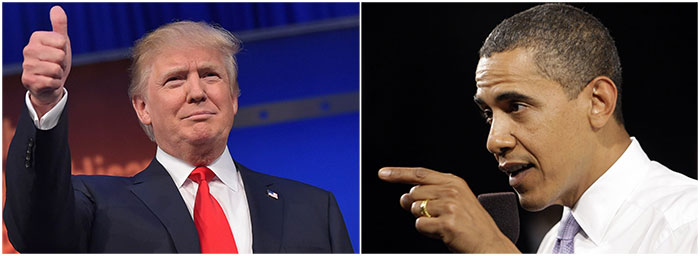World News

- Super User
- Category: World News
- Thursday, 10 November 2016 18:08
US 2016 elections: The complete results, maps and analysis that explain Donald Trump's shock victory to become President...
Donald Trump has pledged to be a president "for all Americans" after being elected the 45th President of the United States, capturing crucial victories over Hillary Clinton in a remarkable show of strength.
The president-elect addressed supporters at his victory party in New York City after his Democratic rival Hillary Clinton called him to concede.
While Clinton had a higher share of the popular vote than Trump, the Republican was able to take a series of key battleground states including Florida, Ohio and North Carolina, before stunningly carrying Pennsylvania, a state that had not backed a Republican for president since 1988.


The celebrity businessman clinched victory after capturing Wisconsin's 10 electoral votes, putting him over the 270 threshold that a candidate needed to secure to become President.
Mr Trump will govern with a Congress fully under Republican control. The GOP fended off a Democratic challenge in the Senate and the party also extended its grip on the House.
Presidential results maps
The electoral map is important. Each state is worth a certain number of electoral college votes, so it was essential that Trump and Clinton built a coalition of states to reach the magic number of 270.
A series of close Trump wins in crucial states in Florida, Ohio and North Carolina meant that he was able to gain the number of electoral votes he needed.
Our chart below sizes each state by their number of electoral college votes, showing how the big states have the power to tilt the election.

The key states in the election
Swing states with a lot of electoral votes to distribute, such as Florida and Ohio, have been targetted a lot by Clinton and Trump in recent weeks. How they end up voting would have a lot of influence on the final result.
States like Arizona, Florida, North Carolina, Ohio and Virginia had the power to swing the election. All but one of these five crucial states went to Trump.
Demographics were thought to be of importance here. Before electoral day, polling revealed a country divided down demographic lines. A country where men and whites tend to back Trump, while women and ethnic minorities flock to the Democrat's candidate.
These demographic splits did come to light to a certain extent, but a key part in Clinton's failure to claim certain states was the fact that ethnic minorities and women didn't back her in the numbers initially expected.

Trump triumphed in Ohio. This reliable bellwether state is worth a very handy 18 electoral college votes but its claim to fame is that it is the only one to have backed the successful presidential candidate in every election since 1964.
As such its result was seen as very significant when determining the outcome of the race nationwide, with polling in Ohio was showing Trump marginally ahead of Clinton at the start of November. Situated on the Great Lakes, it is the seventh most populous state in the country.
Minority ethnic voters hold less sway here, with 83 per cent of the population being white according to the 2010 census compared to 72 per cent across the US as a whole.

Trump won Florida’s vote for the 2016 presidency, marginally ahead of Clinton. Florida has been one of the hardest to call swing states in this election with the margins between the two candidates in recent polling being too close to call.
A week before the big day, polls were showing that Trump had taken a slight lead in the battle to take the state’s 29 electoral college votes. Florida is at once the oldest and one of the most racially diverse in America, and its voting in the past five presidential races has followed the result of the country as a whole.
Both candidates have had multiple campaign stops here in recent weeks. The state played a pivotal role in the 2000 election, when out of more than 5.8 million votes Bush beat Gore by 537 votes to claim all of its electoral college votes.

Clinton triumphed in Virginia. Although not quite the boost that a state the size of Florida would give, Virginia’s 13 electoral college votes was a very handy addition for Clinton. Prior to Obama’s victory in 2008, Virginia had been a red state for the past forty years.
Nowadays, one in five of its people are black or African American, part of an increasingly moderate population based in its urban areas.
This shifting of demographics meant that the state was expected to stay Democrat this time around, with polls showing Clinton eight points clear of Trump at the end of October. Situated on the Atlantic coast, Virginia was the first colonial possession established in British America.

North Carolina’s voters have chosen Trump as their preferred presidential candidate. This result will be a blow for Clinton as North Carolina has been one of the toughest states to call in this election. Its 15 electoral college votes means that it is a valuable prize in the race to that all important 270 mark.
North Carolina was highly coveted this year with the candidates making multiple campaign stops there in the fortnight leading up to election day.
While Obama won it in 2008 with the assistance of demographic shifts and liberal urban areas, Romney managed to claim it for the Republicans in 2012 - the only swing state Obama lost in the last presidential election. This southeastern state is the ninth most populous in America and has a lower white population, at 64 per cent, than the average state.
Which states did Trump swing from Obama?
There are at least five states that swung from Obama in 2012 to Trump in 2016: Florida, Ohio, Wisconsin, Pennsylvania and Iowa. All of these were essential battlegrounds that both candidates canvassed hard.


Trump's biggest victories
Trump's most emphatic victory came in the state of Wyoming where he won 174,248 votes - a 70.1 per cent share.
With most votes already counted Trump looks to have secured the votes of at least three in five voters in 10 states while Clinton can only boast the same vote share in five.

Many voted for neither candidate
Over six million people voted for third party candidates in this election - tripling the number since 2012.
Exit polls showed how dissatisfied Americans were with both candidates, and this shows in the number of people who voted for a candidate that wasn't Trump or Clinton.

Congressional elections
The Senate and the House of Representatives, the two chambers that comprise America's legislature, also have elections. Both of these chambers were in Republican hands prior to voting.
Senators are being elected in 34 states with the Republicans having a strong chance of holding onto their majority in the chamber.
The Republicans are on course to hold onto the Senate with a slightly reduced majority.

The House of Representatives is held more firmly in Republican hands with their majority of 59 looking very difficult to overturn even if Clinton had had a good day.
All 435 seats in the House were up for re-election with many having already called the result in favour of the republicans.

SOURCE: Telegraph

















































































